Do you already know what the Valle d’Itria offers you?
Discover the main places to visit or the best attractions
The Beaches Of Your Dreams
The entire Puglian coast, where wide beaches of fine sand alternate with cliff sections, is renowned for its crystal clear waters and natural beauty. The nearest sea (7 km) to the village is the coast of the “Capitolo”. Savelletri, another next resort is suitable for those who love the cliff. However the coastal road, offers the tourist an incredible variety of choice of a corner where to stop to bathe and sunbathe. There are also many kiosks that offer fish specialties and maybe in the evening have fun, listening to music and dancing.
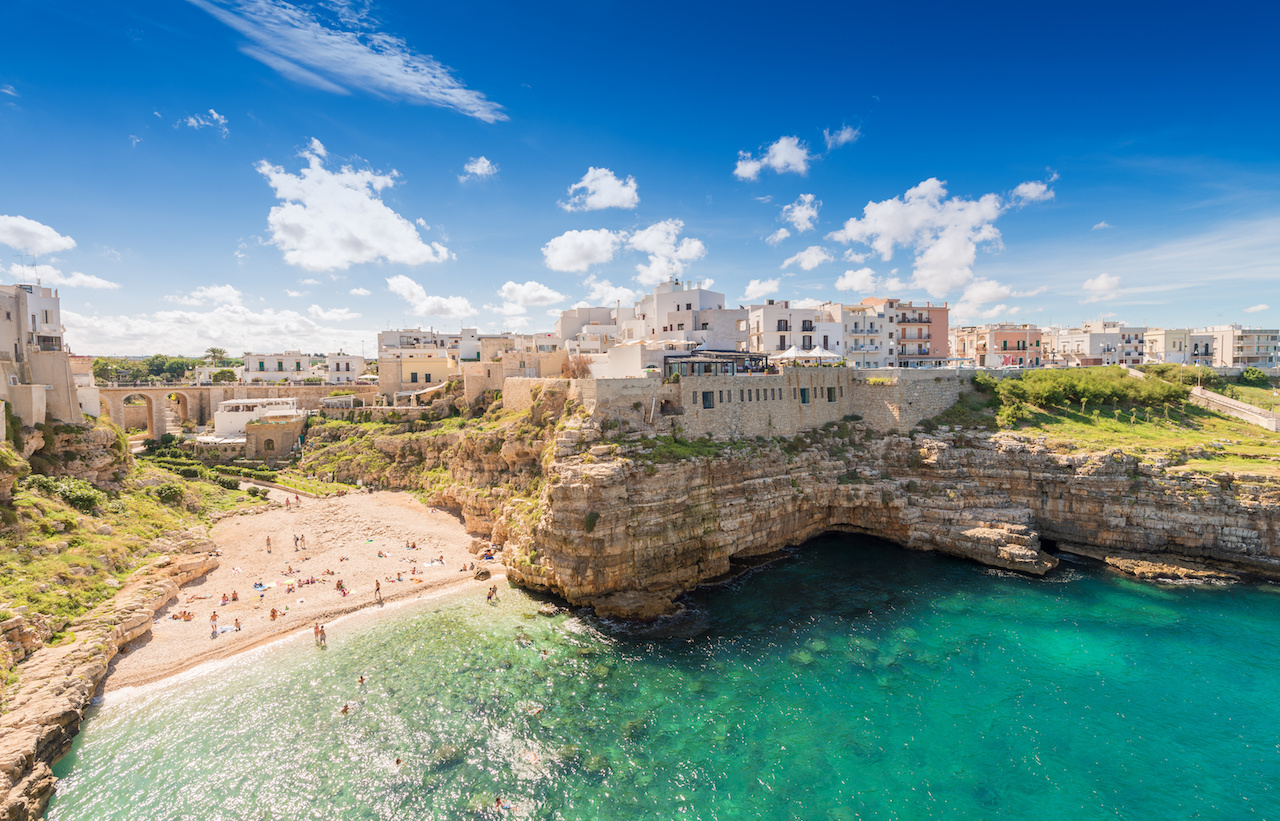
With its 14 km of coast Carovigno has a beautiful diversified coastline where you can come across a unique landscape characterized by low cliffs or real gullies, small coves or large beaches, such as the one in the Specchiolla. In the upper Salento this inlet overlooks the warm Adriatic sea embraced by a white sandy beach where in addition to the deep blue sea are easily accessible also places of cultural interest, historical but also of relaxation and fun.
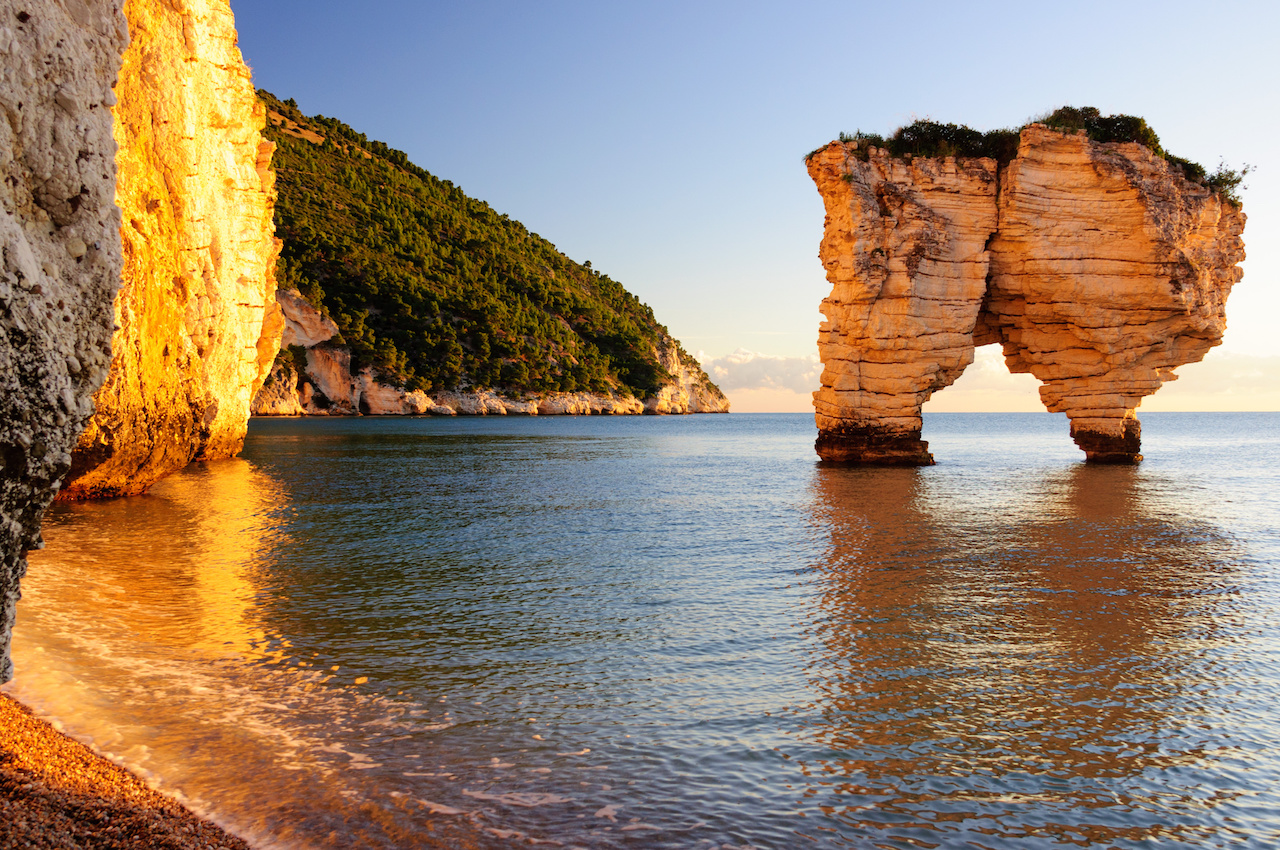
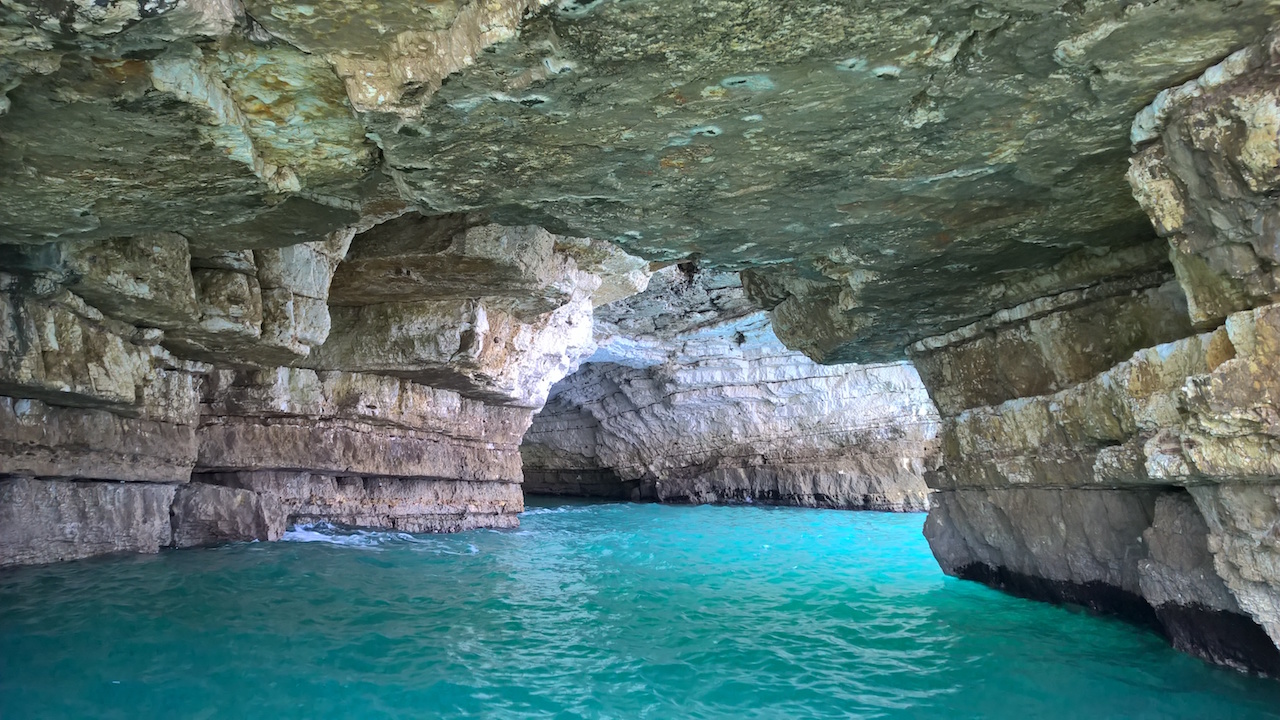
The Heritage that UNESCO recognizes
Alberobello, in Puglia, with its Trulli is one of 51 Italian sites included by Unesco in the World Heritage List.
The name comes from the late Greek “dome” and indicates ancient conictable dry stone constructions of prehistoric origin. The stone used for the construction was made from the limestone rocks of the Murge Plateau.
The Trulli, mainly found in the Itria Valley, located between the provinces of Brindisi, Bari and Taranto, are still used today as dwellings and constitute a brilliant and long-lasting example of spontaneous architecture.

Alberobello, a town in the Bari hinterland, is definitely the capital of the Trulli: the old town is fully made up of these particular pyramid-shaped buildings that make it unique in the world.
According to some studies, Alberobello’s trulli date back to the mid-14th century; At the time it was common to tear down and rebuild the broken buildings, rather than repair them.
The dry construction, without mortar, seems to have been imposed on the peasants in the 15th century by the Counts of Conversano, to escape an edict of the Kingdom of Naples that imposed tributes to every new urban settlement. These buildings were therefore precarious, easy to demolish and not taxable.
In truth, the trulli are far from precarious: the internal structure, although lacking elements of support and connection, has an extraordinary static capacity.
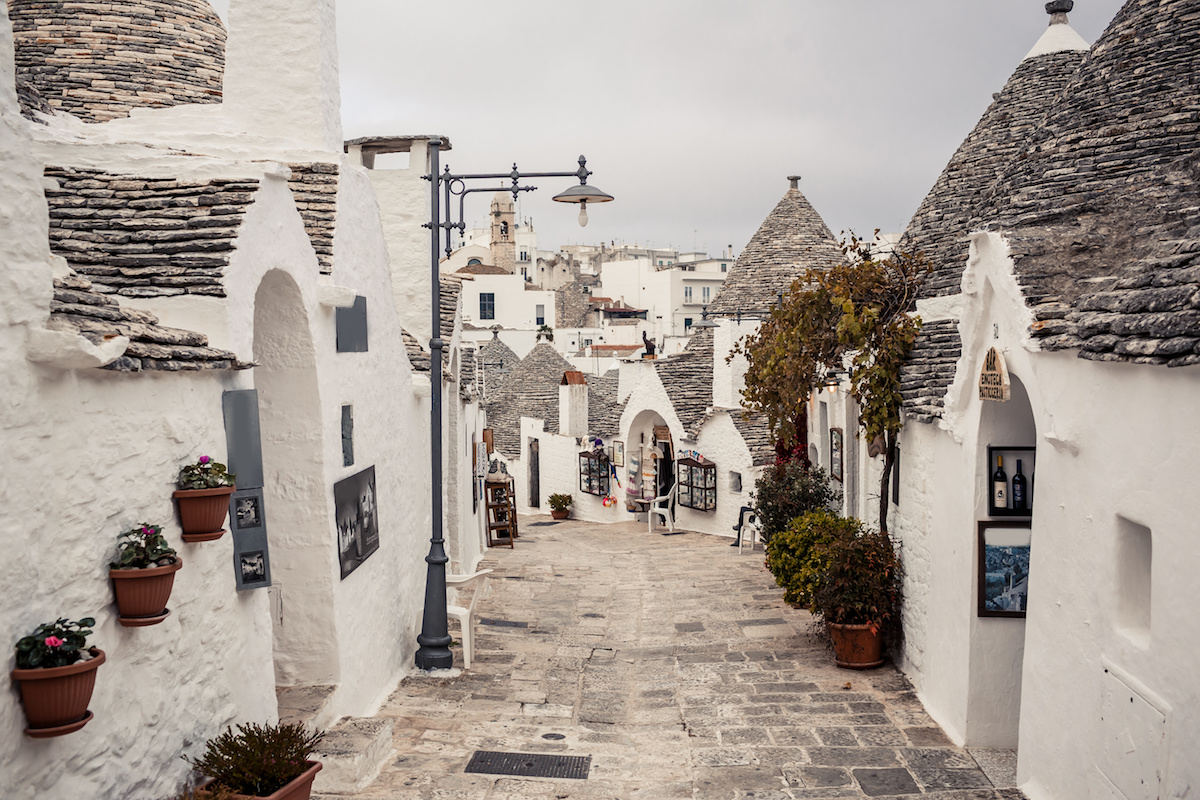
The trullo plant is approximately circular; on the base of natural rock is grafted the heavy masonry in lime.
Generally the trulli are modular units: the interiors are distributed around the central compartment. The thickness of the walls and the lack of windows ensure an optimal thermal balance: warmth in winter and cool in summer.
The roof is composed of a pseudo-dome of horizontal limestone slabs placed in ever smaller concentric series – the so-called “chianche” (inside) and the thint “chiancarelle” (outside).
The keystone, often decorated with esoteric, spiritual or propitiatory motifs, is very important. Ingenious the presence of a ledge protruding from the roof used for the collection of rainwater in special tanks.
Trulli are a unique example of ancient construction that survives and is still used today. Visiting the beautiful Alberobello is like taking a trip to a timeless country.
Ostuni
It welcomes you with those expanses of olive trees as nowhere else in the world there are so beautiful ones, born from that red earth that smells and that makes the panorama around a succession of wonderful chromatic effects.
It is the Valle d’Itria, also known as the Valley of Trulli, which stretches between the provinces of Bari, Brindisi and Taranto and includes the municipalities of Alberobello, Carovigno, Castellana Grotte, Ceglie Messapica, Cisternino, Fasano, Locorotondo, Martina Franca, Noci, Ostuni, Putignano, San Michele Salentino, San Vito of the Normans and Villa Castelli.
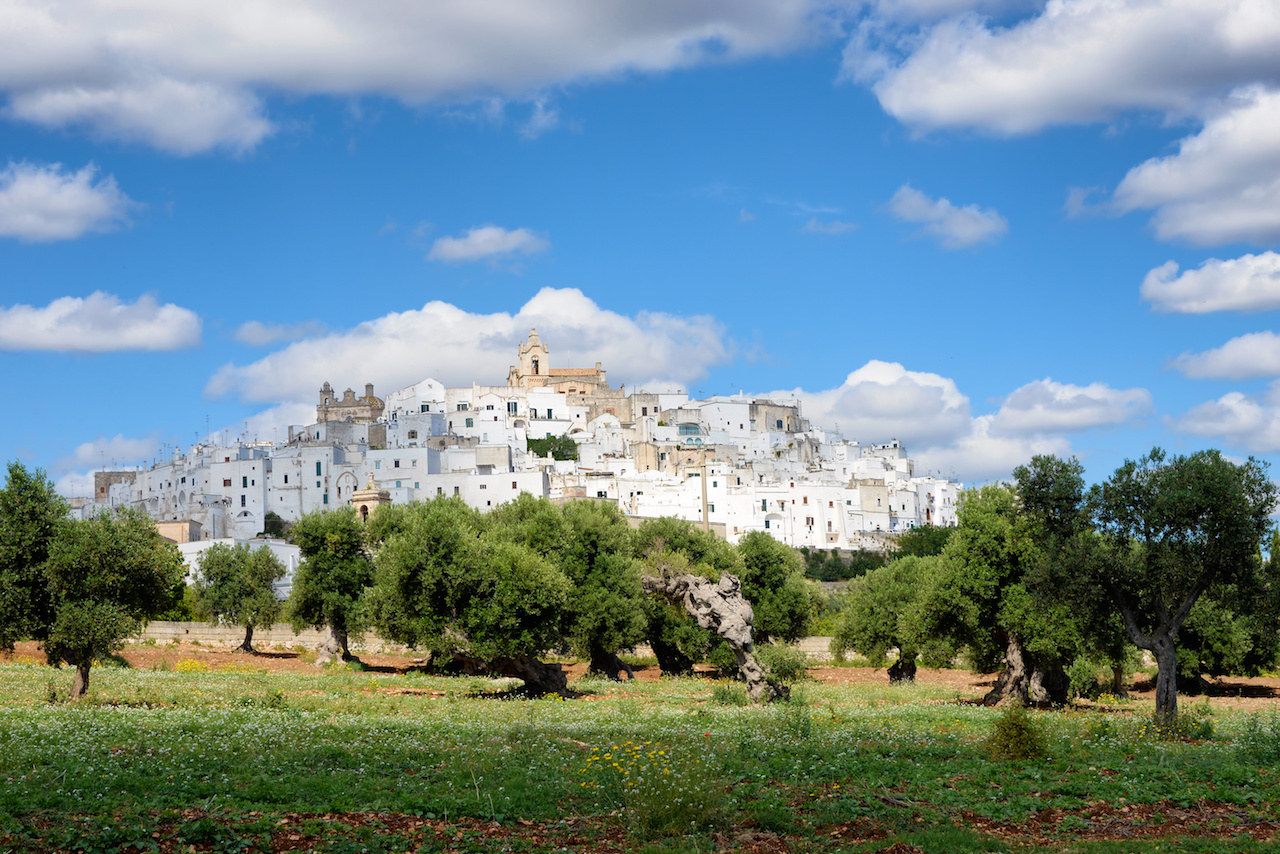
It will be for the white of the buildings, or for the vegetation that frames them, but every village in the valley is enveloped by a magical, almost fairytale atmosphere.
In the heart of the Itria Valley is Alberobello with its trulli, listed by Unesco in the World Heritage List in 1996. It is impossible not to be fascinated by the streets of the rione Monti and Aja Piccola wards.
But it’s not just Alberobello. The countryside throughout the area is scattered with these typical buildings: just think of Cisternino, which is located in the so-called Murgia dei trulli, counted, together with the nearby Locorotondo, among the most beautiful villages in Italy. The latter, called until the mid-nineteenth century “Luogorotondo” for the characteristic round shape of the town, is part of The Land of Trulli.
Absolutely not to miss a “journey to the center of the earth”, to the Caves of Castellana (in the municipality of Castellana Grotte), where the Grave, the first and largest cave and the only one connected to the outside, then the White Cave will leave any words Visitor.
Leaving for a few kilometers the province of Bari, there is Martina Franca, the most populated municipality of the Valley of Itria, best known for its beautiful Baroque architecture and the music festival of the same name.
And then there is the White City par excellence, the only one in the valley with an outlet on the sea: Ostuni. It is so named because of its characteristic old town, once entirely painted in white lime, today only partially. Ostuni is one of the ideal summits of the Salentina peninsula with Taranto and Santa Maria di Leuca.
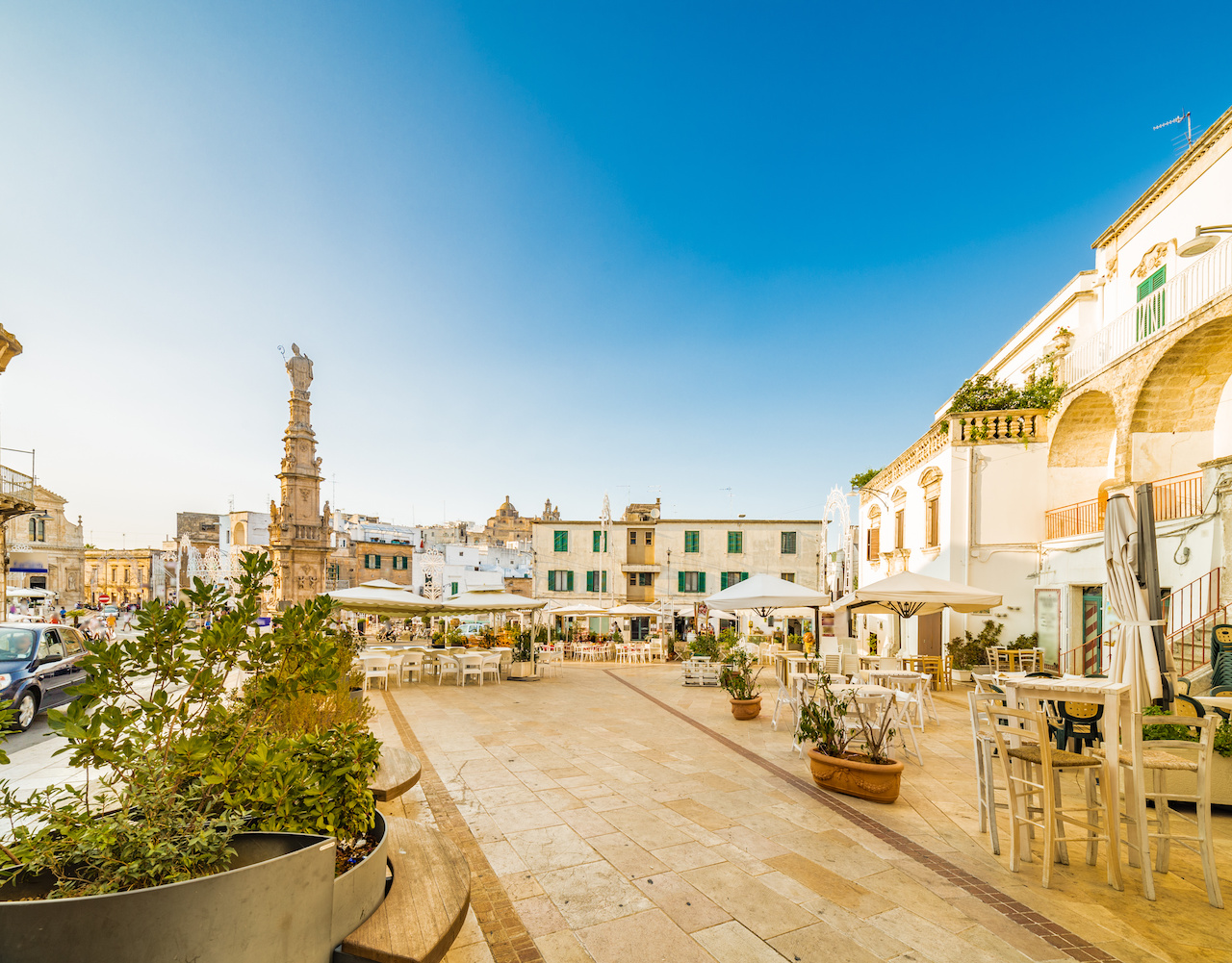
The visit to the Caves of Castellana, open all year round, is carried out with the help of expert tour guides.
Walks, workshops and tastings at the many educational farms, that is, farms distributed throughout the territory that offer, for schools, but not only, direct experiences of observation and study, and then manipulations, collection fruits, participation in the various stages of processing of agricultural products, creation of small objects in rushes, tasting of typical products.
Zoo Safari Fasano
The Wildlife Park Zoo Safari Fasano, opened on 25 July 1973 and today considered one of the largest in Italy and Europe, which is home to dozens of animal species that move in semi-freedom on an area of 140 hectares can be visited on board its Car.
.
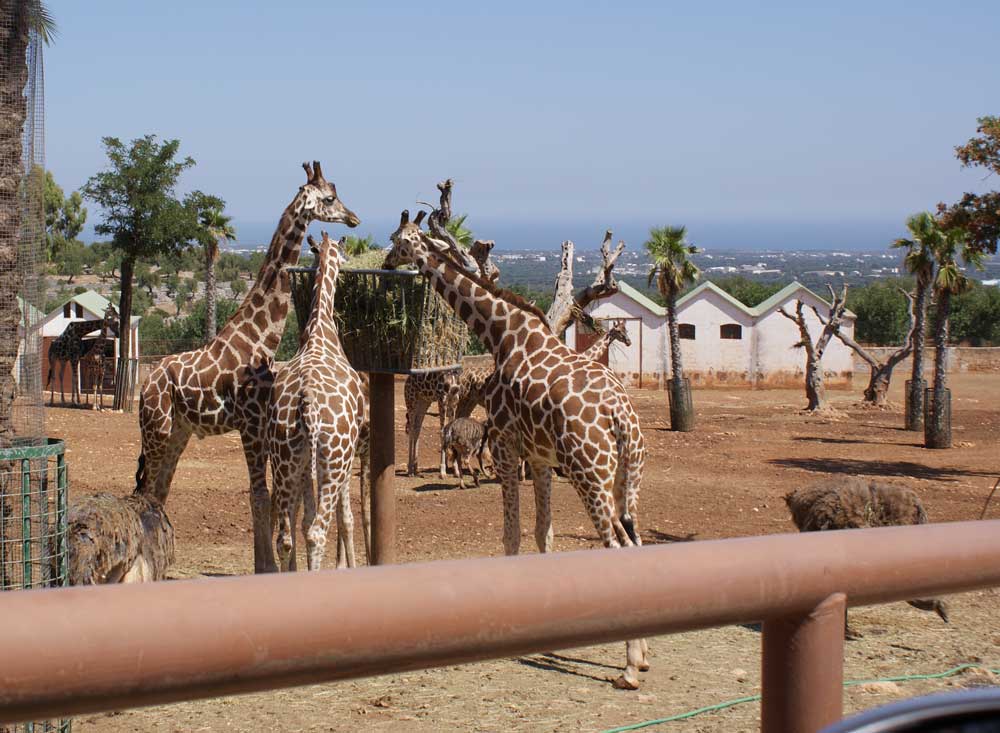
The visit of the Zoosafari takes between one and three hours (including the pedestrian wildlife departments). In the panorama of southern Italy it is definitely one of the best facilities, although it has some limitations, especially on peak days. The efforts made in recent years have been considerable and although we can not indicate it as a park absolutely to visit for users of the Centre-North on holiday (who have the opportunity to visit good facilities at home), it still offers the if combined with the visit of Fasanolandia, a whole day full of fun for the whole family.
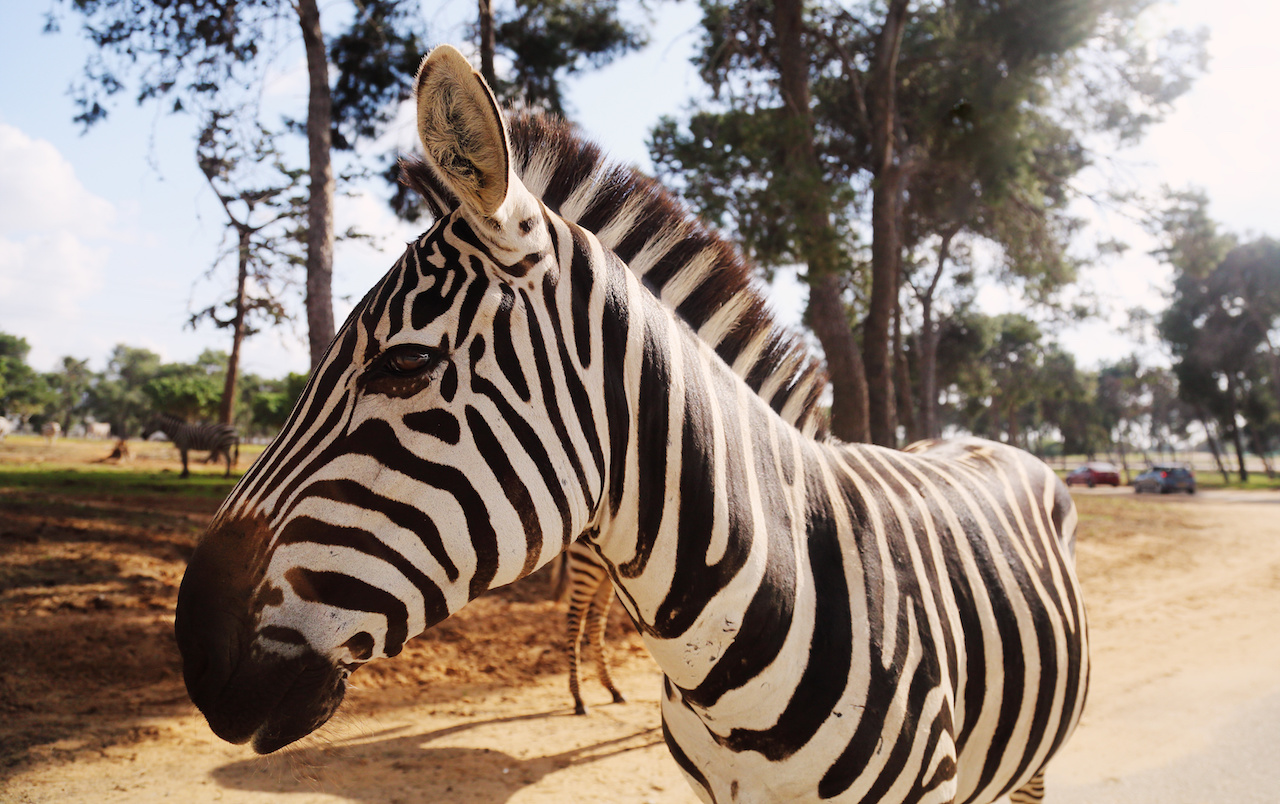
Fasanolandia, an amusement park located in the municipality of Fasano in the province of Brindisi, which boasts more than 25 attractions, including shows and mechanical rides of various kinds designed to guarantee a full day fun to the whole family.
Highlights of Fasanolandia include the new Eurofighter roller coaster, the African River floating log route, the Spinning Coaster Spinning Madness, the 30-metre-high Sputnik fall tower, the Mirage Red inverted coaster, the 4D Adventure cinema, the route on Rapis River dinghies, the Flying House, Cloud, the big Ferris wheel and many other rides dedicated to children.
AcquaPark Egnazia
The name chosen by the “Zoosafari Group” for its brand new Monopoly water park is “AquaPark Egnazia“, this choice is the result of a long and careful analysis of the components that characterize the structure and the suggestions that, the local boys, have expressed in the referendum held among the schoolchildren of the municipality of Bari. The proximity to the well-known archaeological site of Puglia has undoubtedly been an active part in the preference of the name, but even more in stimulating the creativity of marketing. The marketing of the “Zoosafari Group” had to carry out in-depth studies on the history of the place. A well-paid work considering that these studies have highlighted interesting and surprising similarities between the uses and customs of the people who lived at the time “Egnatia” and how much you want to achieve with this modern construction.
The ancient center of Egnatia was positioned in the middle between two important territories; Peucezia: a name that was attributed to the present province of Bari and The Messapia: territory that corresponded to the present Salento. “Egnatia” as it was called by the Romans or “Gnàthia” as the Greeks indicated it, was already an important location from the 8th century BC is often mentioned by the greats of Latin literature: Plinio, Strabone, Orazio.
The various dominations that followed in the management of “Egnatia”, Messapi, Greeks, Carthaginians, Romans, had in common a particular adoration for water and for religious ceremonies related to it. The highest moment of these aquatic cults was certainly in the Augustan phase when the “Temple of Cibele” was built near the Acropolis, which also included an environment with a bathtub and communicating with the “Sacello of Eastern Deities”.
One of the functions hypothesized for this large pool was the luxertral one, that is, a ceremony that served to purify the athletes before their entry into the temple or at the exit after having performed their bloody rites. Even the Greek culture towards water was no less than that of Rome. The Greeks to the water have always conferred great taumaturgical powers for the healing of many evils and for this reason they have always given her a particular attachment. Thalassotherapy (“thalassa” sea and “therapeia” treatment) was born in Greece based on the healing action of the marine climate.
Never was a water park more so. “AcquaPark Egnazia” combines history, place and recreation thus creating a magical mix that will give beneficial effects, comfortable environment and healthy fun.
The choice of names given to the various areas of the park has been suggested by the history and mythology of the place and each of the myths and heroes connected to that area will be widely presented on explanatory signs. This is also the modus operandi of the “Zoosafari Group” that operates always combining “Fun and Culture”.
Cycling Trail of the Aqueduct Pugliese
The Ciclovia of the Aqueduct Pugliese is a cycle path of about 500 km that follows the route of two historic pipelines of the aqueduct: the Main Canal, from Caposele (AV) to Villa Castelli (BR), which in just nine years (1906-1915) managed to get to the the water in Bari, and the Great Sifone Leccese, which from the end point of the first reaches up to Santa Maria di Leuca (LE), where the infrastructure is celebrated with a monumental waterfall built in 1939. It is a unique “narrative itinerary” that crosses three regions of the South (Campania, Basilicata and Puglia), connecting some of the most fascinating and still undervalued places of the peninsula: High Irpina, Vulture Melfese, Alta Murgia, Itria Valley, Arneo Land and Salento hinterland.
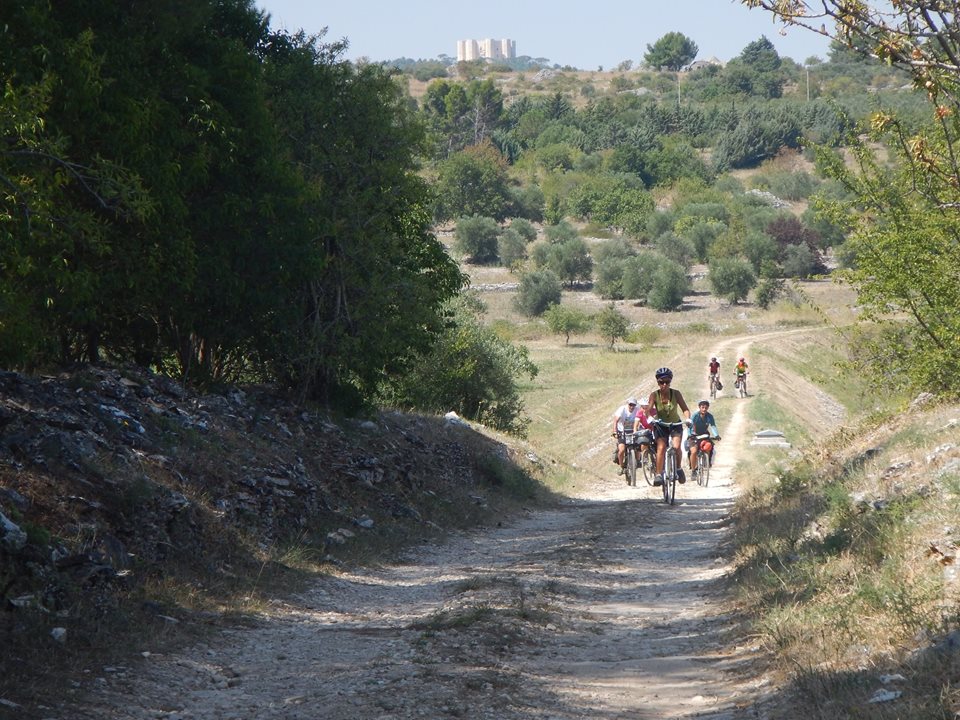
The most important thing to point out is that this track can count on about 230 km of existing and almost entirely walkable roads (tracks). A cycle route that for half of its route then becomes green, barred from motorized traffic. The “greenway” part includes a first stretch on the border between Campania and Basilicata and then a very long stretch, interrupted only for a few km, from Venosa (PZ) to Seclì (LE). Many rural and local roads can be used in Salento and Irpinia, while there are no stretches to travel on dangerous and busy state and provincial roads.
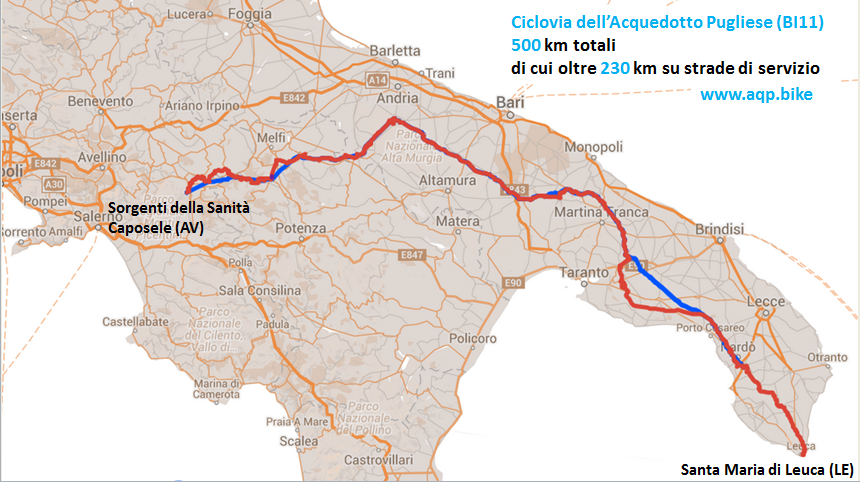
The Ciclovia and Via Verde of the Aqueduct Pugliese therefore needs an intelligent project of restoration and enjoyment rather than transformation/conversion, preserving as much as possible authenticity and naturalness of the historical infrastructure. The minimum and priority interventions that could make it one of The most important green routes of sustainable tourism in Europe in a short time are essentially:
- the adaptation of the gates already present to protect a large part of the service roads to allow the transit of bikes and pedestrians
- securing crossings and side barriers and putting signs along the route.
The Ciclovia of the Aqueduct Pugliese is a great opportunity to recover and enhance the works of one of the largest and most complex aqueducts in the world.
Martina Franca, a city not to be missed
The town of Martina Franca was founded in the 10th century, when some citizens, who fled the Saracen devastation of Taranto, built a village on Mount S. Martino, a high slope that lies on the hills of Murgia.
It is a city famous especially for its Baroque buildings, such as the Panelli, Blasi and Motolese palaces, all enriched by lodges decorated in wrought iron.o.
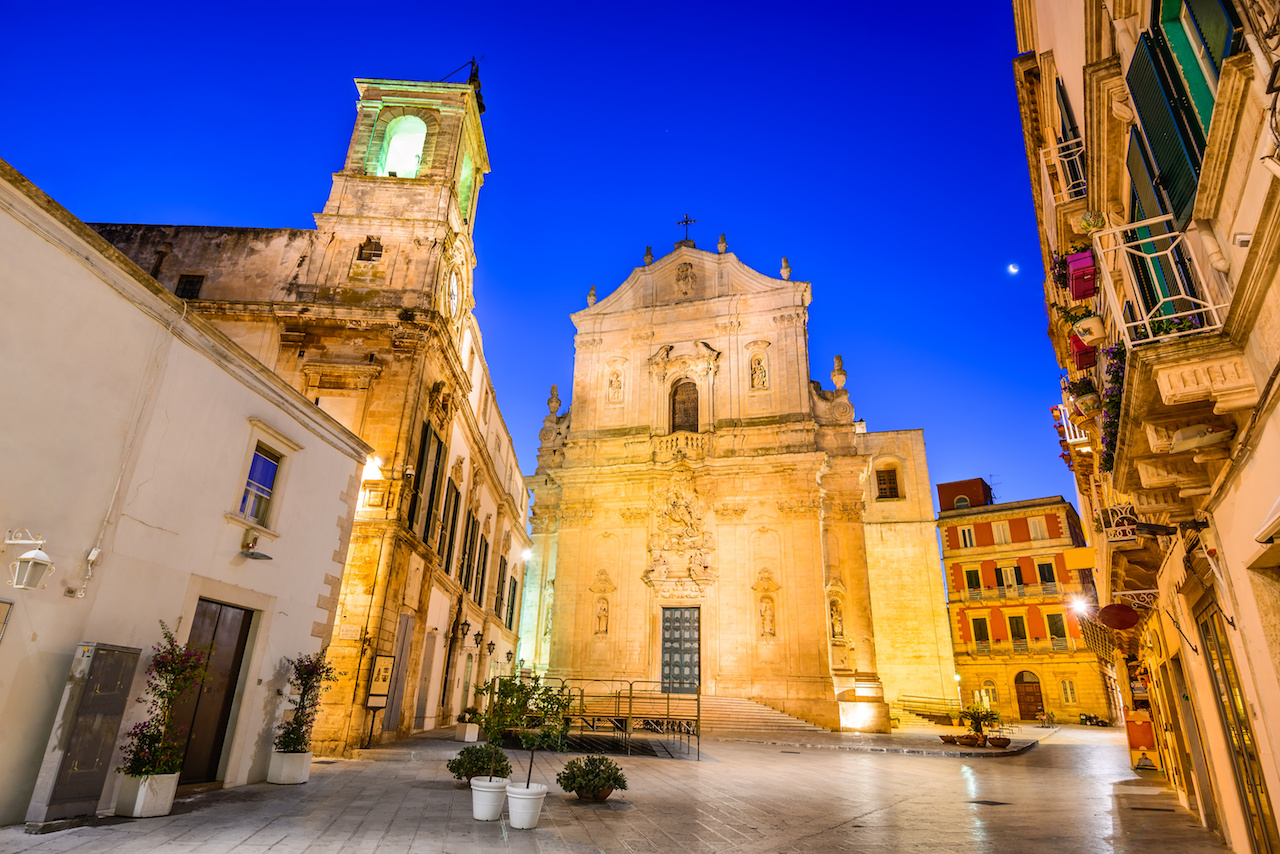
Among the buildings to be seen absolutely stand out:
- The Basilica of St. Martin, dedicated to the Holy Patron, St. Martin of Tours, lived in the 4th century A.D. It was erected in the second half of the eighteenth century, on the initiative of the archbishop Isidoro Chirulli. It is a Rococo-style church with a beautiful facade and a portal decorated with a sculpture in high relief of the Saint Martin and the poor. The interior is home to some rich and colorful marble altars.
- The University Palace, which during the Middle Ages was the seat of the local parliament, which was a group of citizens, with equal rights and without social distinctions, who came together to talk and address the problems of common interest. It was a fundamental political institution that Ferdinando d’Aragona, king of Naples, granted to Martina to ensure a just administration of the city’s resources.

- The Piazza Maria Immaculata, known as the Portici, is a large semi-elliptical space of neoclassical style with a semi-circular structure, characterized by a succession of thirteen arches.
- The Civic Tower, built in 1734, is a four-level square tower, each with different architectural and decorative features. The first level has, at the corners, round columns and, on the facade, a sundial. On the second level there is a pair of paraste with a balcony with a broken eardrum and curved eardrum in the center. On the third level there is a clock of round shape and, on the top floor, the turret with four arches on the sides.

